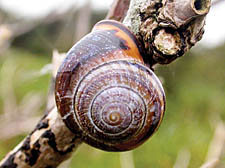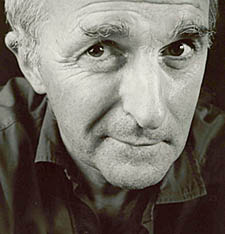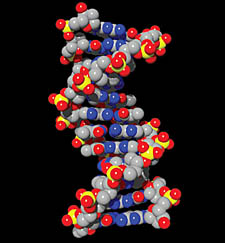|
|
 |
| |

The helix of the title refers to snails, while paying
homage to James Watson’s book on DNA

Professor Steve Jones

|
Science essays to dispel myth of common
sense
We can understand science using
cricket, cats and dogs, writes Lewis Wolpert
The Single Helix by Steve Jones
Little, Brown, £12.99
SCIENCE can be difficult for non-scientists as the world is
not built on common-sense principles. Any common-sense view
of how the world works is almost certainly wrong scientifically.
It goes against common sense that when we are in a plane at
a constant 400mph there is no force moving us forward –
force, as Newton made clear causes acceleration not motion.
So it is important that scientists like Steve Jones can open
up science for the general reader, though even some of his ideas
are testing.
Though Steve Jones is a professor of genetics, this is not
a book about DNA. The title pays homage to James Watson’s
wonderful book about DNA, The Double Helix. Jones has worked
a lot on snails and used the current title, somewhat flippantly
in an article for the science journal Nature as it contained
reference to a common snail – helix. Nature did not like
it and a duller title was used. But the incident gives some
insight into Jones’s character and particularly his sense
of humour. This comes out again in this series of some 100 essays,
each about 800 words long, that were originally published in
the Daily Telegraph science page.
These essays are his attempt to translate scientific ideas,
with their arcane language, into plain English. As the author
of a number of successful books and scientific papers and an
outstanding lecturer – he is a colleague of mine at University
College – he has no problem. Science communication to the
public is not great in the UK and he is disappointed with science
on TV which is too much presented as a soap opera. The range
of the essays is astonishing and ranges from errors in the pound
note with Newton’s portrait but the sun in the wrong place,
to astronomy and the speed of light. Sex is not absent, and
voles are obsessively monogamous due to a hormone which he refers
to as “infatuin”‚ which increases in the male
vole within minutes of mating.
Not surprisingly, as Jones is also an evolutionary biologist,
several of the essays touch on evolution in various ways. For
example, he is enraged by cats that urinate on his plants each
morning, and considers whether London’s cats are an evolutionary
experiment which has resulted in them having more independence
than its dogs. Then there is cricket, where he shows that its
evolution has resulted in a decrease in those with a lifetime
average batting score above 50. I share many of his views but
we probably disagree about what we can say about the evolution
of human behaviour and beliefs, such as religion, by considering
how our ancestors might have lived. He regards such theories
as untestable and so not scientific – but I have just written
a book about the evolutionary origins of belief. I am sure he
will not like it. He also gives insufficient attention to the
development of the embryo which is fundamental to evolution.
Changes in genes change how animals and plants develop.
But there are genes and genetics in the essays. He explains
the importance of the gene that codes for the protein p53 which
is involved in the defence by our cells against cancer. But
Jones complains about the tedious names given to genes such
as p53 and ApoE4 which is involved in Alzheimer’s disease.
He does however appreciate the eccentricity of some of the names
given to genes involved in development of animals such as Sonic
Hedgehog which was first named Hedgehog in the fly because of
a mutation caused the larva to look like one, and then had Sonic
added to the related gene in vertebrates, because of a cartoon
character which a researcher’s child loved.
The gin bottles in his room are not an indication that he is
a heavy drinker, but are central to a study of the evolution
of the advertising of gin. But I do think he is correct when
he says that absinthe, which I sometimes drink, is noxious not
because of the wormwood in it – rather it is its very high
alcohol content that caused all the trouble in France.
The big killer in absinthe is present too in cider and Chardonnay.
It is interesting that the belief that drinking vodka caused
flower arrangers to be more creative.
We share the view that modern attempts to unite art and science
are often little more than a publicity stunt. I also like what
his maths teacher told him – mathematics is like a bikini
as it shows what is interesting but conceals what is essential.
And I am struck that Camden once had a time of endless summer
days, even at Christmas, some half a billion years ago. Continental
drift changed all that as we all know too well. A most impressive
and fascinating collection.
|
|
 |
|



